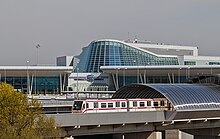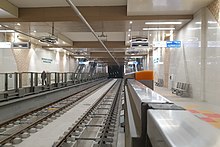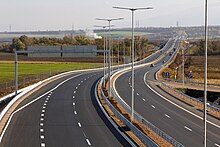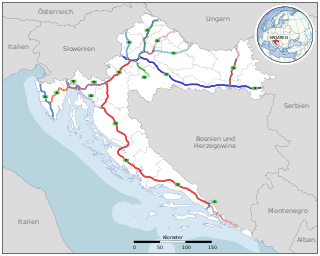
Transport in Croatia relies on several main modes, including transport by car, train, ship and plane. Road transport incorporates a comprehensive network of state, county and local routes augmented by a network of highways for long-distance travelling. Water transport can be divided into sea, based on the ports of Rijeka, Ploče, Split and Zadar, and river transport, based on Sava, Danube and, to a lesser extent, Drava. Croatia has 9 international airports and several airlines, of which the most notable are Croatia Airlines and Trade Air. Rail network is fairly developed but regarding inter-city transport, bus tends to be far more common than the rail.

The transport system of Finland is well-developed. Factors affecting traffic include the sparse population and long distance between towns and cities, and the cold climate with waterways freezing and land covered in snow for winter.
In 1995, the main means of transportation in Moldova were railways and a highway system. The major railway junctions are Chișinău, Bender, Ungheni, Ocnița, Bălți, and Basarabeasca. Primary external rail links connect the republic's network with Odesa on the Black Sea and with the Romanian cities of Iași and Galați; they also lead northward into Ukraine. Highways link Moldova's main cities and provide the chief means of transportation within the country, but roads are in poor repair. The country's major airport is in Chișinău.

The Netherlands is both a very densely populated and a highly developed country in which transport is a key factor of the economy. Correspondingly it has a very dense and modern infrastructure, facilitating transport with road, rail, air and water networks. In its Global Competitiveness Report for 2014-2015, the World Economic Forum ranked the Dutch transport infrastructure fourth in the world.
Transportation infrastructure in Romania is the property of the state, and is administered by the Ministry of Transport and Infrastructure, Constructions and Tourism, except when operated as a concession, in which case the concessions are made by the Ministry of Administration and Interior.
Transport in Slovakia is possible by rail, road, air, or rivers. Slovakia is a developed Central European country with a well-developed rail network (3,662 km) and a highway system (854 km). The main international airport is the M. R. Štefánik Airport in the capital, Bratislava. The most important waterway is the river Danube, which is used by passenger, cargo, and freight ships. The two most important harbours in Slovakia are Komarno harbour and Bratislava harbour.

The location at the junction of the Mediterranean, the Alps, the Dinarides and the Pannonian Plain and the area being traversed by major rivers have been the reasons for the intersection of the main transport routes in Slovenia. Their course was established already in Antiquity. A particular geographic advantage in recent times has been the location of the intersection of the Pan-European transport corridors V and X in the country. This gives it a special position in the European social, economic and cultural integration and restructuring.

Transport in the United Kingdom is facilitated by road, rail, air and water networks. Some aspects of transport are a devolved matter, with each of the countries of the United Kingdom having separate systems under separate governments.

Transport in Ukraine includes ground transportation, water, air transportation, and pipelines. The transportation sector accounts for roughly 11% of the country's gross domestic product and 7% of total employment.
Transport in Serbia includes transport by road, rail, air and water. Road transport incorporates a comprehensive network of major and minor roads. Rail transport is fairly developed, although dual track and electrification are not very common. Water transport revolves around river transport while air transport around country's three main international airports.

Transport in Albania consists of transport by land, water and air, which are predominantly under the supervision of the Ministry of Infrastructure of Albania. The development and improvement of the transport in the country remains among the most important priorities of the Government of Albania.
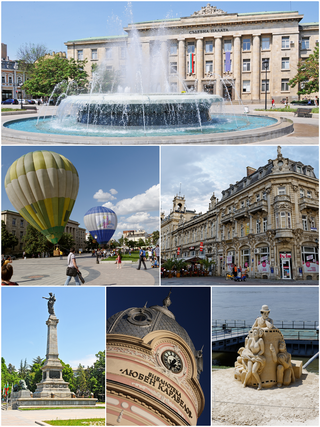
Ruse is the fifth largest city in Bulgaria. Ruse is in the northeastern part of the country, on the right bank of the Danube, opposite the Romanian city of Giurgiu, approximately 67 km (42 mi) south of Bucharest, Romania's capital, 172 km (107 mi) from Varna, and 249 km (155 mi) from the capital Sofia. Thanks to its location and its railway and road bridge over the Danube, it is the most significant Bulgarian river port, serving an important part of the international trade of the country. It is the 12th largest of all cities on the Danube river.

Varna Airport is the airport of Varna, the historical maritime capital of Bulgaria. Varna Airport is the third largest airport in Bulgaria. It is located 10 kilometers from the center of Varna near the town of Aksakovo. The airport serves Varna, Golden Sands and northeastern Bulgaria. The busiest season for the airport is from the end of May to the beginning of October.

Burgas Airport is an international airport in southeast Bulgaria and the second largest in the country. It is near the northern neighbourhood of Sarafovo approximately 10 km (6.2 mi) from the city centre. The airport principally serves Burgas and other seaside resorts of the Bulgarian south coast which attract many tourists during the summer leisure season.
Bunavad was the first national airline of Bulgaria. The airline was conceived in late 1926, operated scheduled services between major Bulgarian cities from October 1927 and closed in 1930.

The Bulgarian Black Sea Coast, also known as the Bulgarian Riviera, covers the entire eastern bound of Bulgaria stretching from the Romanian Black Sea resorts in the north to European Turkey in the south, along 378 km of coastline. White and golden sandy beaches occupy approximately 130 km of the 378 km long coast. The region is an important center of tourism during the summer season (May–October), drawing millions of foreign and local tourists alike and constituting one of the country's most popular tourist destinations. Prior to 1989 the Bulgarian Black Sea coast was internationally known as the Red Riviera. Since the fall of the Iron Curtain, however, its nickname has been changed to the Bulgarian Riviera.

The Trakia motorway or Thrace motorway, designated A1, is a motorway in Bulgaria. It connects the capital city of Sofia, the city of Plovdiv and the city of Burgas on the Black Sea coast. The motorway is named after the historical region of Thrace, the northern (Bulgarian) part of which it spans from west to east. The total length of Trakia motorway is 360 km (220 mi) and the final section opened on 15 July 2013 after 40 years of construction.

Plovdiv Airport is an airport that serves the second largest city in Bulgaria, Plovdiv, and is the country's 4th busiest airport behind Sofia Airport, Burgas Airport and Varna Airport. It is sometimes referred to as Plovdiv Krumovo Airport, after a small village located 6 km south-east away from the city on the main Plovdiv-Asenovgrad second class road.
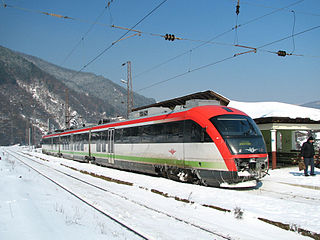
Rail transport in Bulgaria includes passenger and freight operations over its 4,070 km (2,530 mi) network of mostly 1,435 mmstandard gauge railways. It is an important mode of transport in Bulgaria. Its infrastructure is owned by the National Railway Infrastructure Company (NRIC), and services are operated, among others, by the Bulgarian State Railways (BDŽ).

The Corridor VIII is one of the Pan-European corridors. It comprises both road and rail routes. Both commence on the Italian Adriatic coast at Bari or Brindisi, with a ferry crossing to Durrës in Albania. From there the routes cross the southern Balkans into Bulgaria and thence to Varna, on the Bulgarian Black Sea coast. The road corridor follows the route: Tirana/Durrës/Vlorë – Elbasan – Skopje – Pernik – Sofia – Plovdiv – Burgas – Varna. Although as yet incomplete, it is broadly paralleled by the rail route: Durrës/Vlorë-Lin-Radožda-Kičevo-Skopje-Kumanovo-Beljakovtse-Kriva Palanka-Gyueševo-Sofija-Burgas-Varna.

